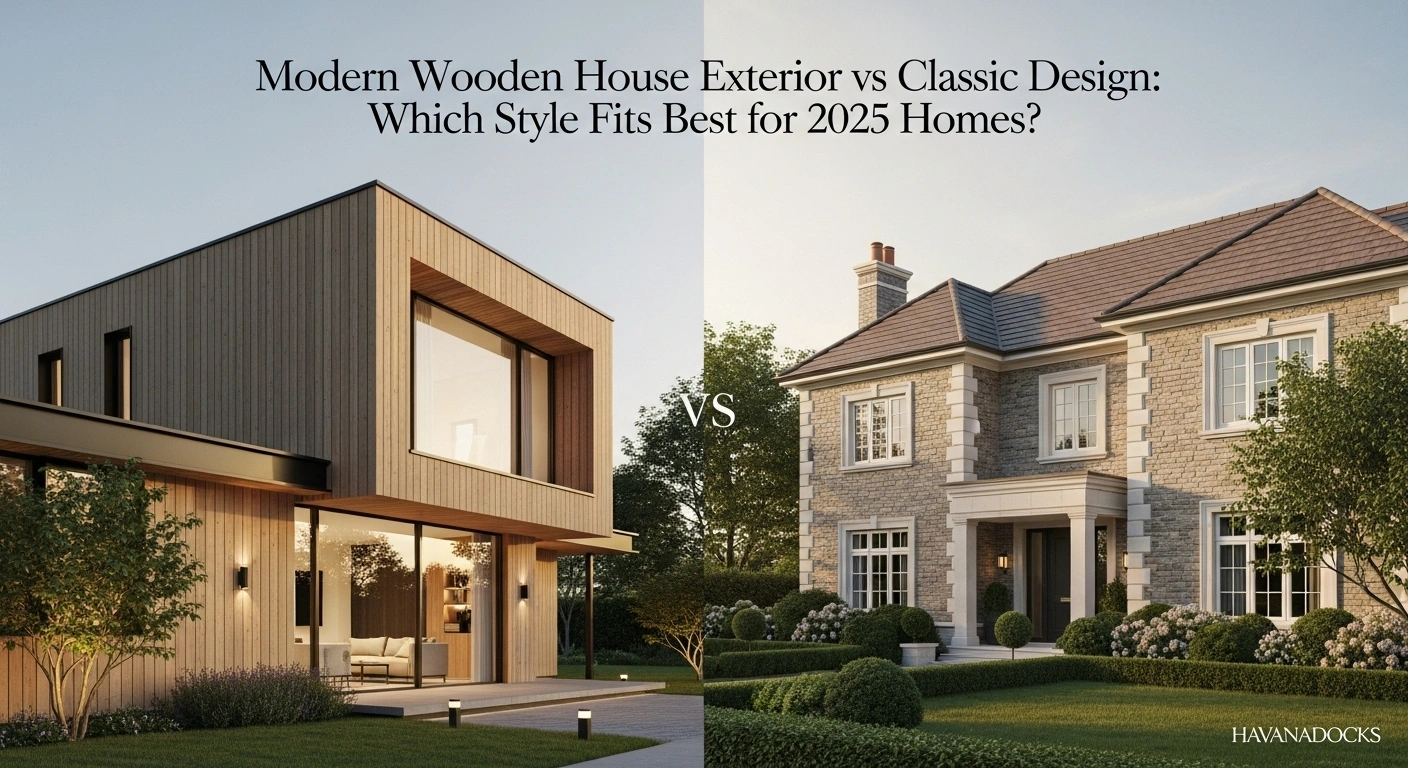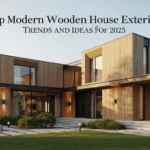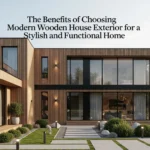Modern Wooden House Exterior vs Classic Design: Which Style Fits Best for 2025 Homes?
Modern Wooden House Exterior vs Classic Design: Which Style Fits Best for 2025 Homes? – Choosing the architectural style for your future home is more than a simple aesthetic decision. It is the first brushstroke on the canvas of your life, a choice that will define your daily experience for years to come. This decision sets the tone for your sanctuary, your family’s haven, and your single largest investment.
As we stand on the cusp of 2025, a compelling architectural debate takes center stage for aspiring homeowners. Do you embrace the time-honored elegance of traditional forms, or do you opt for the clean, nature-centric appeal of a modern build? This is the core of the Modern Wooden House Exterior vs Classic Home Design dilemma, a choice between legacy and innovation.

The Soul of Timelessness: Unpacking Classic Home Design
Classic home design is a language of enduring grace spoken through generations of architecture. It is built on principles of symmetry, order, and ornate detailing that evoke a sense of history and permanence. This style represents a connection to the past, a solid foundation in a rapidly changing world.
These homes are often characterized by materials like stately brick, dignified stone, and traditional stucco. Architectural archetypes such as the grand Colonial, the intricate Victorian, or the charming Craftsman fall under this grand umbrella. A classic design promises not just a house, but a legacy.
The Dawn of a New Era: The Rise of the Modern Wooden House Exterior
The story of the modern wooden house exterior is one of quiet revolution — a graceful reawakening of our connection to nature, authenticity, and human-scale design. For decades, architecture equated modernity with steel, concrete, and glass — materials of permanence and progress. But as we step into 2025, the world has shifted. The new definition of sophistication is not found in cold perfection, but in the warmth of natural imperfection. The modern wooden home is the embodiment of this evolution — a structure that breathes, adapts, and grows with time.
This architectural movement is not simply about aesthetics. It is a philosophy of living, rooted in the belief that our homes should nurture the soul as much as they shelter the body. Clean lines, minimalist silhouettes, and expansive openings define the modern wooden house, but beneath this simplicity lies profound intentionality. Every joint, plank, and beam has purpose; every surface tells a story. The result is an architectural poetry that balances logic with emotion, and structure with serenity.
Where the classic home exterior once emphasized grandeur and ornamentation, the modern wooden exterior celebrates purity and restraint. Instead of elaborate moldings or decorative excess, the eye is drawn to the play of light across a flat timber plane, the rhythm of horizontal cladding, or the quiet dialogue between wood and glass. Here, simplicity does not mean emptiness — it means clarity. The absence of unnecessary detail allows the materials to speak, transforming architecture into meditation.
A defining feature of this new wooden modernism is its relationship with transparency. Expansive glazing — sometimes stretching floor to ceiling — erases the division between the natural and built environment. Mornings are painted with soft sunlight that filters through the grain of wood, while evenings invite the golden glow of interior light to spill out into the landscape. In this way, the modern wooden house does not dominate its setting; it becomes part of it.
Material Honesty: The Beauty of Authentic Expression
Perhaps the most compelling element of the modern wooden house exterior is its honest materiality. In a world saturated with synthetic finishes and disposable construction, there is something profoundly grounding about the tactile presence of real wood. Each species — whether cedar, oak, teak, or thermally modified pine — offers a distinct personality. The subtle variation in tone and texture ensures that no two homes are ever truly alike.
In these homes, timber is not disguised beneath paint or plaster; it is celebrated in its raw form. Designers and homeowners alike are rediscovering the poetic power of wood’s natural patina — how it silvers softly in the sun, how rain darkens its tone, how time leaves behind a gentle record of living. This acceptance of imperfection marks a cultural shift away from mass-produced uniformity and toward authenticity and permanence.
The combination of wood with materials like steel, stone, and glass adds balance and complexity. Cool metal frames and warm timber cladding create a tension that feels both contemporary and timeless. Concrete foundations ground the structure, while wooden facades soften it — a marriage of strength and warmth that defines the essence of modern architecture today.
Sustainability as a Statement of Ethics
In 2025, no architectural discussion is complete without addressing sustainability, and here, the modern wooden house exterior shines. Far from being a nostalgic choice, timber is one of the most advanced materials in modern construction. Responsibly sourced wood is renewable, carbon-efficient, and highly adaptable. New technologies such as cross-laminated timber (CLT) and thermally modified wood have revolutionized the way architects use this ancient material, making it stronger, more durable, and resistant to weathering and pests.
These innovations mean that wooden exteriors can now rival — and often outperform — traditional materials in longevity and performance. When paired with passive design principles, such as strategic window placement and natural ventilation, a wooden house can dramatically reduce its energy consumption. Many modern wooden homes also incorporate solar panels, rainwater harvesting, and green roofs, reinforcing a holistic approach to sustainability.
But perhaps the greatest environmental contribution of wood is emotional: it fosters respect for the natural world. Living within timber walls creates an ongoing awareness of the material’s origin — the forests, the growth rings, the life once lived. This awareness encourages a mindset of stewardship, not consumption.
The Emotional Architecture of Warm Minimalism
There is an emotional intelligence to modern wooden architecture that sets it apart from other contemporary styles. It offers not just visual calm, but psychological warmth — a grounding presence that counters the sensory overload of modern life. The tactile quality of wood, its subtle scent, and its responsiveness to light and temperature create an atmosphere that is deeply human.
The modern wooden house is not cold or sterile; it’s minimalism with a heartbeat. It invites touch, interaction, and reflection. It supports a lifestyle of clarity and purpose — one that values experiences over possessions, and mindfulness over material excess.
Designers are increasingly recognizing that homes are not just spaces for living, but spaces for healing. The wooden house becomes a kind of architectural sanctuary — a refuge from the digital noise and artificial intensity of modern urban life. It is a quiet protest against disposability, an argument for longevity and meaning.
A Vision for the Future
Ultimately, the rise of the modern wooden house exterior marks a turning point in architectural history. It represents a reconciliation between technology and nature, between innovation and tradition. These homes are designed not to impress from the outside, but to endure gracefully from within. They adapt to the changing rhythms of their inhabitants, the seasons, and the environment.
In 2025 and beyond, wood is no longer just a building material — it’s a statement of values. It is about living in harmony with one’s surroundings, choosing sustainability without sacrificing beauty, and embracing simplicity as the truest form of luxury.
The modern wooden house exterior is not a fleeting trend; it is the architecture of the future, grounded in the wisdom of the past. It embodies a new kind of elegance — one that whispers rather than shouts, breathes rather than dominates, and connects rather than isolates.
The Enduring Appeal of Tradition
The emotional gravity of classic home design is undeniable. It taps into a collective nostalgia for stability, heritage, and the quintessential image of “home.” These structures feel permanent, as if they have always been and always will be.
This sense of permanence translates into tangible market value. Classic designs have a proven track record of holding their value and appealing to a broad range of buyers. Opting for a classic home is often seen as a secure and wise investment for the long term.
Materials and Craftsmanship: The Classic Signature
The beauty of a classic home is often found in its meticulous details. Think of the intricate cornices, the stately columns, and the multi-paned windows arranged in perfect symmetry. These are not mere decorations; they are testaments to a tradition of fine craftsmanship.
The materials themselves contribute to this powerful narrative of endurance. The rich texture of aged brick tells a story of warmth and community. The solid presence of cut stone speaks of strength and prestige, creating an exterior that is as robust as it is beautiful.
Potential Drawbacks of a Purely Classic Approach
However, a rigid adherence to classic design is not without its challenges for the 2025 homeowner. The very details that provide charm can also demand significant maintenance and upkeep. Ornate woodwork and older window styles can be less resilient to the elements over time.
Furthermore, traditional layouts can sometimes feel compartmentalized and dark compared to contemporary open-plan living. They were designed for a different era, and retrofitting them for modern energy efficiency standards can be both complex and costly. This is a key consideration in the Modern Wooden House Exterior vs Classic Home Design debate.
Why 2025 is Leaning Towards the Modern Wooden House Exterior vs Classic Home Design
The world is changing, and our values are evolving with it. The home of 2025 is expected to be more than just a shelter; it must be a sustainable, healthy, and restorative space. It is this fundamental shift in priorities that is tilting the scales in the Modern Wooden House Exterior vs Classic Home Design discussion firmly towards the modern.
Homeowners today seek a deeper connection with nature, a commitment to environmental responsibility, and living spaces that promote well-being. Modern architecture, particularly with its emphasis on wood, directly addresses these contemporary desires. It is the architecture of now, designed for the lifestyle of tomorrow.
Sustainability and Biophilic Design: A Core 2025 Value
Biophilia, the innate human desire to connect with nature, is a driving force in contemporary design. A modern wooden house exterior, with its vast panes of glass and use of natural materials, erases the boundary between inside and out. It invites the landscape in, creating living spaces that feel calming, expansive, and alive.
Wood itself is a champion of sustainability. As a renewable resource, it has a significantly lower carbon footprint than concrete or steel when sourced responsibly. Advanced building techniques, such as cross-laminated timber (CLT) and superior insulation methods, make modern wooden homes exceptionally energy-efficient, reducing both environmental impact and long-term utility costs. This represents a huge advantage when evaluating the Modern Wooden House Exterior vs Classic Home Design choice.

The Aesthetics of Simplicity and Light
The modern aesthetic celebrates the principle that less is more. By removing clutter and unnecessary ornamentation, it creates a sense of calm and order. This minimalist approach allows the quality of the materials and the beauty of the surrounding environment to take center stage.
Light is a primary material in modern design. Floor-to-ceiling windows, open-concept floor plans, and strategically placed skylights drench the interiors in natural daylight. This not only reduces the need for artificial lighting but also has proven benefits for mental health and well-being. It transforms a house into a bright, uplifting, and energizing environment. This focus on light and space is a powerful argument for those weighing the Modern Wooden House Exterior vs Classic Home Design options.
Embracing Technology and Innovation
The clean lines and simple forms of a modern wooden house exterior provide the perfect canvas for integrating state-of-the-art technology. Sleek solar panels can be seamlessly incorporated into a flat or angled roof design without disrupting the aesthetic. Smart home systems for lighting, climate control, and security are more easily integrated into the build from the ground up.
This forward-thinking approach extends to the construction process itself. Prefabrication and modular construction techniques, often employed in modern designs, can lead to faster build times, higher quality control, and less construction waste. It is a smarter, more efficient way to build for the future.
Customization and Personal Expression
While classic design often adheres to a strict set of historical rules, modern architecture offers a liberating sense of freedom. The minimalist framework allows for a high degree of personalization. You can create a home that is a unique reflection of your personality and lifestyle.
Whether it’s a dramatic cantilevered second story, a unique combination of vertical and horizontal wood cladding, or a bold color accent, modern design empowers you to make a statement. It allows your home’s exterior to be a piece of functional art. This level of self-expression is a compelling factor in the Modern Wooden House Exterior vs Classic Home Design showdown.

The Hybrid Solution: Blending Modern Wooden House Exterior vs Classic Home Design
Why must you be forced to choose? The most forward-thinking solution for 2025 lies not in a stark division between two styles, but in their intelligent and beautiful fusion. This hybrid approach allows you to harness the very best of both worlds, creating a home that is both timeless and perfectly contemporary.
Imagine a home with the familiar, comforting gabled roofline of a classic farmhouse, but rendered with the clean lines and materials of modern design. Picture a structure that features the solid, reassuring presence of a stone foundation, which gives way to warm cedar siding and expansive glass walls on the upper floors. This is the future of residential architecture, a harmonious blend born from the Modern Wooden House Exterior vs Classic Home Design dialogue.
This approach lets you honor tradition while embracing innovation. You can have the symmetrical layout and welcoming front porch of a classic home, but with an open-concept interior that flows seamlessly into a minimalist backyard oasis. You could use traditional materials like brick but in a modern application, such as a sleek, unadorned feature wall. The possibilities are truly endless, allowing for a home that feels both grounded and visionary. Thinking beyond the binary of Modern Wooden House Exterior vs Classic Home Design opens up a world of creative potential.
The “Modern Farmhouse” is a perfect, popular example of this successful fusion. It takes the comforting silhouette of a classic barn or farmhouse and reimagines it with black-framed windows, vertical siding, and minimalist interiors. It proves that you can have the emotional resonance of the past without sacrificing the light, space, and functionality of the present. This synthesis is the ultimate answer to the Modern Wooden House Exterior vs Classic Home Design question.
By selectively borrowing elements from each style, you create a design narrative that is rich and personal. You might use reclaimed wood beams—a nod to classic craftsmanship—within a soaring, open-plan living space filled with natural light. You could frame a classic entryway with modern, minimalist landscape lighting. This thoughtful integration creates a home with layers of character and depth that a purely classic or purely modern design might lack.
When considering the Modern Wooden House Exterior vs Classic Home Design debate, this hybrid path offers unparalleled flexibility. It frees you from the constraints of any single doctrine, empowering you and your architect to design a home that is perfectly tailored to your site, your lifestyle, and your unique aesthetic vision. It is the ultimate form of personalized luxury for 2025.
This philosophy of blending styles allows your home to age gracefully. A purely trend-driven modern home might look dated in two decades, while a rigid classic replica might feel stuffy. A well-executed hybrid design, however, possesses a unique timelessness, feeling relevant and beautiful for generations to come, truly resolving the Modern Wooden House Exterior vs Classic Home Design conflict.
Conclusion: Crafting Your 2025 Dream Home
The journey to building your dream home is a personal one, and the final decision in the Modern Wooden House Exterior vs Classic Home Design debate rests with you. The classic approach offers a profound connection to history, craftsmanship, and enduring value. It is a choice that speaks of stability and timeless elegance.
Conversely, the modern wooden house exterior answers the call of the future. It champions sustainability, a deep connection with the natural world, and a lifestyle defined by light, simplicity, and well-being. It is the choice for the innovator, the minimalist, and the nature-lover.
But for the discerning homeowner of 2025, the most compelling path forward may be the one that walks between these two worlds. By thoughtfully blending the strength and grace of classic design with the clean, sustainable spirit of the modern wooden exterior, you can create a home that is more than just a style. You can build a sanctuary that is uniquely yours, a place that is both a timeless legacy and a bold vision for the future.






